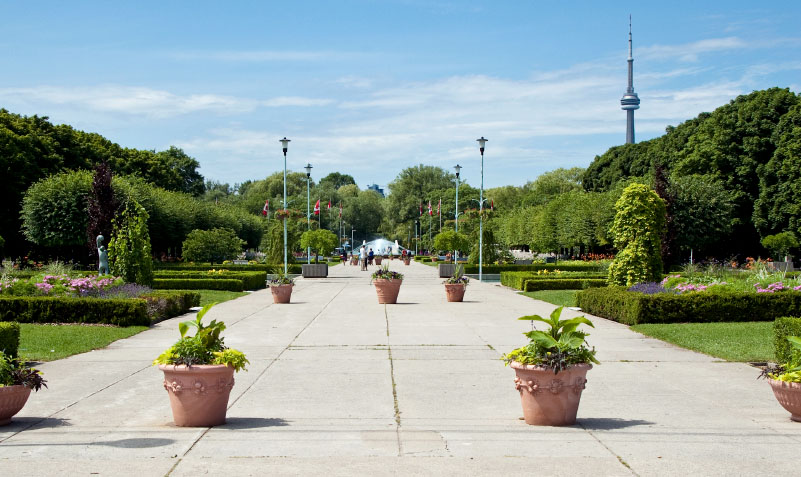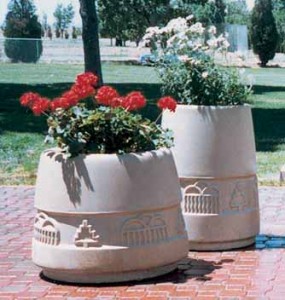 Commercial concrete planters also function as traffic barrier
Commercial concrete planters also function as traffic barrier
By Alysa Kleinman
Spring is here! With the sun shining and birds chirping, it's a great time to dust off the winter blues and dress up your facility so it looks fantastic all year long. Commercial concrete planters can help you accomplish this task and do so much more.
While flowers may seem like a simple touch, they cultivate a positive and inviting energy. Besides looking nice, commercial concrete planters can be highly functional and add so much to your facility and community as a whole. These heavier, more solid commercial planters are preferred by many facility managers because they can't be moved, tipped over by the wind, stolen by thieves and they provide a solid traffic and pedestrian barrier.
1. Boost the Mood - Nothing boosts the mood quite like flowers, and there's even science to prove it. Researchers at Harvard University, working with Massachusetts General Hospital, discovered that participants felt happier and more energetic after looking at flowers during the morning hours. Plant some colorful snapdragon or calendula flowers to add a splash of cheerful color at your facility. You may notice more smiles all around with happier guests and co-workers!
 Decorative concrete planter
Decorative concrete planter
2. Create an Inviting First Impression - People are natural observers. From the time they initially drive up to your business or first wander through your park, they will notice your brand and what sets you apart. Commercial concrete planters and other types of planters can create a strong first impression by adding a decorative touch that matches your unique styleâ€â€Âfrom modern to functional to rustic. Place a few planters close together to really add a "wow" factor.
Imagine walking past a stark, bland building. Next door is a facility with trees and colorful flower pots lining a path right to the entrance. Where are you more likely to feel welcome to enter? While it may only be a subconscious effect, there's no questioning the impact that commercial planters have on potential customers.
3. Keep Sidewalks Safe - Commercial concrete planters can protect pedestrians from aggressive or confused drivers by blocking the sidewalk with these sturdy products. It is easy to get turned around when you first navigate a downtown metro. That's especially true when when it's designed for pedestrians, automobiles, and cyclists. Concrete commercial planters placed in strategic spots can serve as barriers to direct traffic and keep both pedestrians and drivers safe.
4. Protect Off-Limits Areas - If you own a park or outdoor facility, commercial concrete planters can also guide pedestrians away from areas that are designed for staff only. For example, if you operate a zoo, you want to direct guests towards the exhibits and away from the zookeeper doors. With plants guarding the areas that are off-limits, guests most likely will not even know that the entrance is there. Meanwhile, an obvious "Do Not Enter" sign can have the opposite affect as a temptation for curious wanderers.
 Concrete planters can help prevent accident
Concrete planters can help prevent accident
5. Help Cyclists - Biking alongside a busy road with vehicles speeding past can be intimidating. In a 2014 study by the National Institute for Transportation and Communities, 70% of cyclists responded that they feel "very comfortable" riding in a bicycle lane protected by planters. This was the highest-rated response, far above painted bicycle lanes. With more accessibility and comfortable bike lanes, more cyclists will opt to bike to work. This lowers emissions and makes a more physically fit society.
How commercial concrete planters can "pop" on any landscape
While flowers may seem like a simple touch, they cultivate a positive and inviting energy. If you don't have a green thumb, then planting new container flowers can be a little intimidating. Simply, it's all about incorporating a variety of shapes, colors and textures to design a planter that looks naturally beautiful. For an arrangement that looks effortless, you will have to actually put extra effort into strategies for the plants you select.
- Complementing your plants is an essential consideration when deciding what to grow. Planting some yellow flowers? Snag some colors at the other end of the color spectrum, like blues and purples. Got some wispy, grass-like Red Bunny Tails planted? Add gynura aurantiaca for a very different velvety, leafy texture. Thinking about planting purple fountain grass? Add some African daisies for a different height and shape. You can easily get very creative with the plants combinations you select.
- Pay attention to growing conditions. You may not want to plant a purple coneflower, which requires full sun, with the shade-loving English Ivy. Different plants also require varying amounts of water, so read the labels carefully to determine flowers that have similar growing conditions.
- Thrillers, fillers, and spillers. If you are new to gardening, these terms might sound strange, but Gardeners.com says this is the key recipe to combining great plants. Thrillers are the tall plants that add height, such as poppies or Red Stars; fillers are horizontal plants that add depth like carnations, daisies, and pansies; spillers are the cascading plants gently hanging from your planter, like morning glories and asparagus ferns.
If your head is spinning from the variety of plants and factors to consider, there are plenty of books and websites to help you make sense of it all. One excellent resource for combining thrillers, fillers, and spillers that have similar growing conditions is this in-depth spreadsheet created by LandonsGreenhouse.com.
Commercial planters can be made from a variety of materials:
- Concrete: As the heaviest material available, commercial concrete planters are extremely durable and do not rot or warp. Thick, light-colored concrete commercial planters protect plants from drastic temperature changes. Plus, they generally cannot be moved without a forklift and deter thieves from walking away with them.
- Fiberglass: fiberglass planters are versatile because they are lightweight.
- Glass fiber-reinforced concrete planters: this is a popular option because these commercial planters are a mixture of strong glass fibers combined with cement to form concrete planters that are lighter than traditional commercial concrete planters.
- Polymer resin: Strong and sturdy while still lightweight, polymer resin planters are resistant to chips, cracks, rust, and scratches. Some versions are 75% lighter than other types of commercial planters.
- Wood and hardwood: Wooden planters provide a classic rustic look that is appealing to the eye. Hardwood is created from shorea plants and does not rot. This type of planter also does not require any finishing.
- Metal: Modern metal planters require no maintenance and can complement your facility with a variety of color options.
For more information about the different types of commercial concrete planters and other types of park and commercial planters visit www.theparkcatalog.com.


